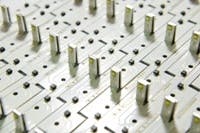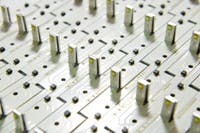This article was published in the February 2013 issue of LEDs Magazine.
View the Table of Contents and download the PDF file of the complete February 2013 issue, or view the E-zine version in your browser.
+++++
MHA Lighting has developed a unique LED approach that opens up the use of solid-state lighting (SSL) in new areas and applications which competitors are failing to address with the same level of efficiency. Using patented intellectual property (IP), MHA Lighting is the only known LED lighting manufacturer to shine light sideways into an encapsulation, rather than directly outwards. This avoids direct eye-contact of the light source, and provides a safe and efficient light output. The flexibility of its patented technology allows MHA Lighting to replace fluorescent fittings and other conventional lighting technologies, in both indoor and outdoor applications, while meeting all relevant standards.
The LED-containing extensions of the PCBs are then inserted into matching holes in an acrylic rod (Fig. 2). For obvious reasons, MHA describes its technology as “Rods with Holes.” The LEDs emit sideways into the rod. Emission from the rod is controlled by a reflective coating which is designed according to the desired light distribution. In this way, light is emitted from the length of the rod in a uniform manner.
The technology overcomes the problem of directionality, and achieves a light distribution of such high uniformity that it is better than traditional fittings. Luminaires create a wide, rugby-ball shape of light to provide exceptional uniformity which for most applications, both internal and external, is crucially important.
The light-waveguide technology used by MHA fits in with a growing industry trend of maximizing “useful lumens,” where light is directed efficiently to specific locations. This is in contrast to traditional light sources, which are typically omnidirectional and wasteful.
Unique approach
MHA’s light-waveguide technology approach differs from technologies used by other LED luminaire manufacturers, which usually shine light directly out of the fixture or scatter the light through an optical diffuser.
Direct emission: In this approach the LEDs are usually arranged in a cluster or matrix to shine their light directly out of the fitting. The earliest forms of LED-based halogen-replacement downlights and fluorescent-tube replacements utilized this approach with mixed results. The light output was limited and in many cases the LEDs would overheat, or the individual light sources were too bright, leaving an uncomfortable after-image for the viewer.
The MHA approach to luminaires differs significantly from either of the above methods. The technology relies on reflecting the light internally and using the optical properties of the acrylic rod before the light is emitted in a uniform manner.
The LEDs are arranged to shine their light sideways within the optic so that only a small proportion of the light is emitted directly from the fitting. The remaining light waves are guided and then subsequently reflected out.
The optical waveguide efficiency of MHA’s Rod with Holes technology is very high and has been evaluated extensively at the UK National Physical Laboratory in Teddington, London. Optical efficiency was found to be in a range of 75-85% depending on the specific system configuration and the required degree of directional beam control.
This efficiency factor includes all the loss factors associated with the light path from the LED to the task plane. By comparison, conventional diffuser-based systems may have efficiencies as low as 50-60%, greatly reducing the overall light output from the fitting. Light diffusers also tend to inhibit any kind of directional beam control, and this may be an important consideration for effective overall light deployment.
The design flexibility inherent in this technology facilitates secondary benefits when used in specific tasks. For example, in street lighting, it is possible to use lower mounting heights, to reduce light pollution, reduce glare and focus light on the task area.
The technology offers a high degree of light uniformity of which the beam angle can be adjusted by a simple modification of the reflector. This has the additional benefit in internal applications, where it is possible to direct light away from windows and concentrate it in required areas or in external applications, such as garage forecourts, where light can be reflected inwards to avoid light pollution.
Visual appearance
In tandem with the beam-control characteristics, the Rod with Holes approach creates a luminaire where light output is perceived as emanating from a light strip or bar, rather than from each individual LED. When individual LEDs can be seen directly, very powerful after-images can be produced along with eye discomfort and glare. The MHA approach yields optimum lighting in an aesthetically-pleasing manner, with fittings that are just as pleasant to look at as a fluorescent.
The Rod with Holes technology encourages a luminaire design in which thermal management can be achieved via a simple passive heat-sinking method. The surface area of the aluminum fitting acts as the heat-sink, and there is no need for active thermal control or an excessively heavy finned heat-sink, for example.
The MHA approach is unique in this respect and can facilitate distinctive designs with aesthetic appeal. Essentially, MHA has a light engine that can be adapted to suit any footprint, depending on the application. The company rarely has to carry out any new product development, as the product range essentially uses variants of the same light engine.









